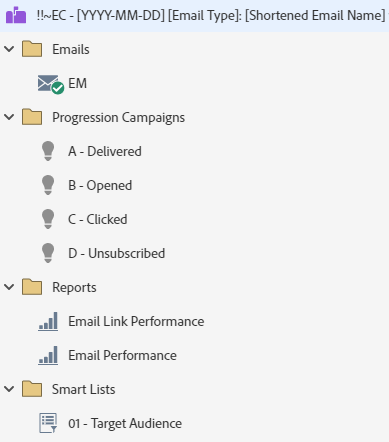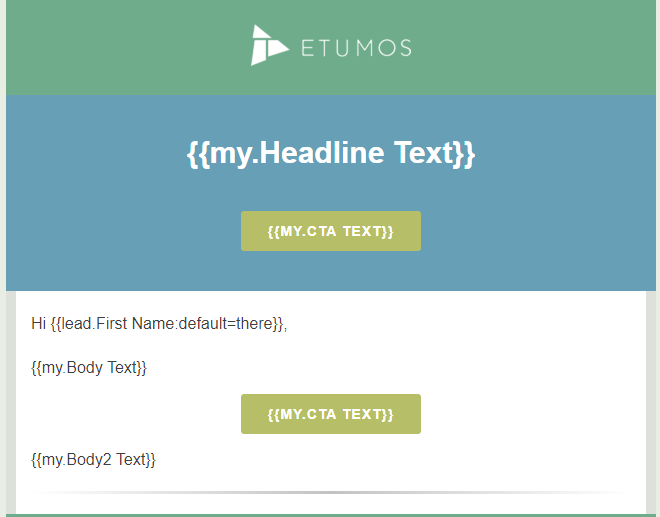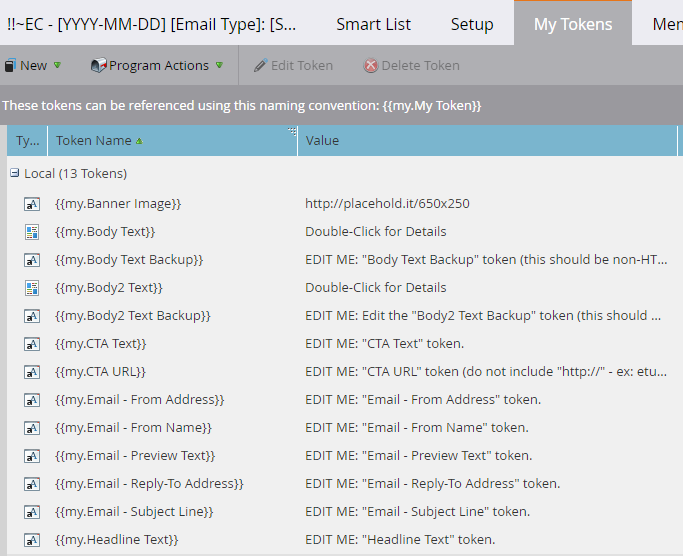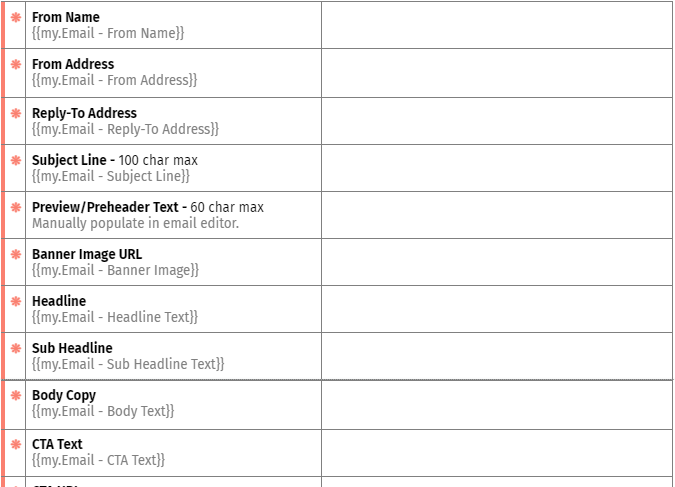Marketo Email Program Templates Guide
The Most Valuable Marketo Email Program Templates You’ll Ever Build
Adobe Marketo Engage program templates help you scale your marketing efforts. Still, surprisingly enough, most companies overlook the most valuable template: the Email Program Template.
This happens because even without a fully tokenized template, getting an email out the door doesn’t take much time. For those who think a tokenized Email Program isn’t worth creating, think again. This template will save you time with every send and reduce the errors that can come from rushing a one-off email.
If you want to know how to build the right email program template that will become your most cloned marketing program, then keep reading.
Before You Begin: Consider the Two Marketo Email Program Types
Marketo has two options for standalone email campaign programs, the Email Batch Program (mailbox icon) and the Default Marketing Program (briefcase icon). Each program type has its advantages and drawbacks. Generally, we use the Email Batch Program for one-off, timely email sends. We use the Default Program for complex, or recurring email sends. We recommend building both out as program templates to serve different needs.
 |
 |
The Email Batch Program (also referred to as “Email Campaign” and abbreviated as “EC”) is more intuitive but more limited than the Default Program. It is excellent for sending a one-time scheduled batch and allows you to leverage advanced functionality such as A/B testing, head start scheduling, and recipient time zone. Another bonus is that you can clone this program type into Event Programs if you need to add a tokenized email quickly.
 |
 |
In the Email Campaign program template, we set a variety of statuses to show the progression of someone’s email engagement. Tracking these statuses at the program level makes it easier to create target audiences based on engagement on future emails or resends.
The more complex and versatile Default Program is the ideal program type for sending the same email repeatedly; this includes resending nurture emails in engagement programs. At Etumos, we refer to email programs nested in engagement streams as “ Nurture Email Cast Programs” (abbreviated to “NE” and shown below).
The Nurture Email Cast program template is designed to be nested in an Engagement Program stream. Each time the Engagement Program stream casts a send, the “Send Email” Smart Campaign is requested within the nested Email Cast program template.
 |
 |
Marketo’s Engagement Programs natively skips a send to any lead who is already a nested program member. This is the program equivalent of skipping a send to a lead that has already received an individual email. If a lead is a member of a program in an Engagement Program stream, they will be skipped to the next program that they are not yet a member of during the same cast.
 |
For this reason, our Nurture Email Cast program contains an “Exclusion” program status that can be set for people who should not receive the email within the program. The exclusion should be run as a batch to target your exclusion audience, and the triggered exclusion smart campaign can also be activated if necessary.
For example, suppose your nurture email is promoting a product demo. In that case, you can exclude leads that have already requested a product demo using the scheduled batch campaign and can then set up a triggered batch to exclude leads that request a demo in the future.
One last added benefit of the Default Program is testing. With this program type, you have access to the Smart Campaign flow. You can nest multiple emails (testing variants) in the same program. You may also use Random Sample for controlled testing to achieve a statistically significant sample size. Additionally, you can use Marketo Champion/Challenger testing. This allows you to improve your nurture emails constantly.
Let’s Get Started
We will start with your most frequently used email use case and then build a program template for each of your primary email use cases. Don’t try to build a separate template for every imaginable email send—apply the 80/20 rule and build the fewest number of program templates to satisfy the majority of your email sends.
Example Use Cases:
- Single body copy email w/ CTA button + banner image
- Single body copy email w/ CTA button, no banner
- Two body copy emails with text below the CTA button + banner image
- Multi-section newsletter w/ images and CTA buttons
For most companies, the most used email is the standard marketing email—an email with a banner image, a single body copy section, and one or two CTA buttons.
 |
The elements within the standard marketing email are straightforward, so many program tokens won’t be needed. However, before we start tokenizing these elements, we must discuss Marketo program types for email.
Tokenizing Your Marketo Email Program Templates
Once you’ve defined the structure of your email, the tokens will be the same regardless of the Marketo Program type you’ll be building with. In this post, we’re talking about building a single-body copy email with a CTA button and banner image.
Here’s a look at the tokens you’ll need for this email:
 |
The token names should be organized and descriptive so that their location and the information they represent are as apparent to you as your Marketing Managers.
An option for taking email tokens one step further is including folder-level tokens. These tokens specify key footer information such as the copyright year, regional office address, and links to your privacy policy. These tokens make it easy to clone your master program template into GEO region folders and serve localized information that can be updated in one place.
Streamlining Your Email Request Process
Once you have your token framework in place, you can streamline the email request process for your Marketing Managers.
Create a simple content submission document for each email template you develop. Have Marketing Managers submit a completed content submission document as part of their request process. The document should contain the token name (for your reference), a brief description of the token, and guidelines for what text, links, or images need to be provided. The advantages of using an approach like this are twofold:
- It will decrease build time, as you’ll have every element of the email provided upfront.
- It will define the email elements that Marketing Managers can customize.
Below is an example email request form:
 |
Misc. Tips & Tricks for Program Template Best-Practices
You’ll be using your email program templates a lot. Since you send so many emails, it’s easy to tweak programs by cloning your last send rather than translating the changes back to your template. Avoid this mistake. It will clutter your instance with outdated templates and create confusion for other users in your instance. Keep the number of templates to as few as necessary, and keep them updated.
What’s Next after this Marketo Email Program Templates Guide?
Have a question? Let’s talk! Contact us if you need help setting up program templates in your instance.
Also, download a copy of The Marketo Expert’s Guide to Advanced Program Templates. It will walk you through how to set up each of the fundamental Marketo program templates.
If you enjoyed this blog but want a little more information and are an auditory learner, listen to our Must Contain podcast episode on Email Templates. It will give you additional food for thought from our VP of Revenue, Kristin Carideo, and our Director of Consulting Services, Kristin Crowe.







